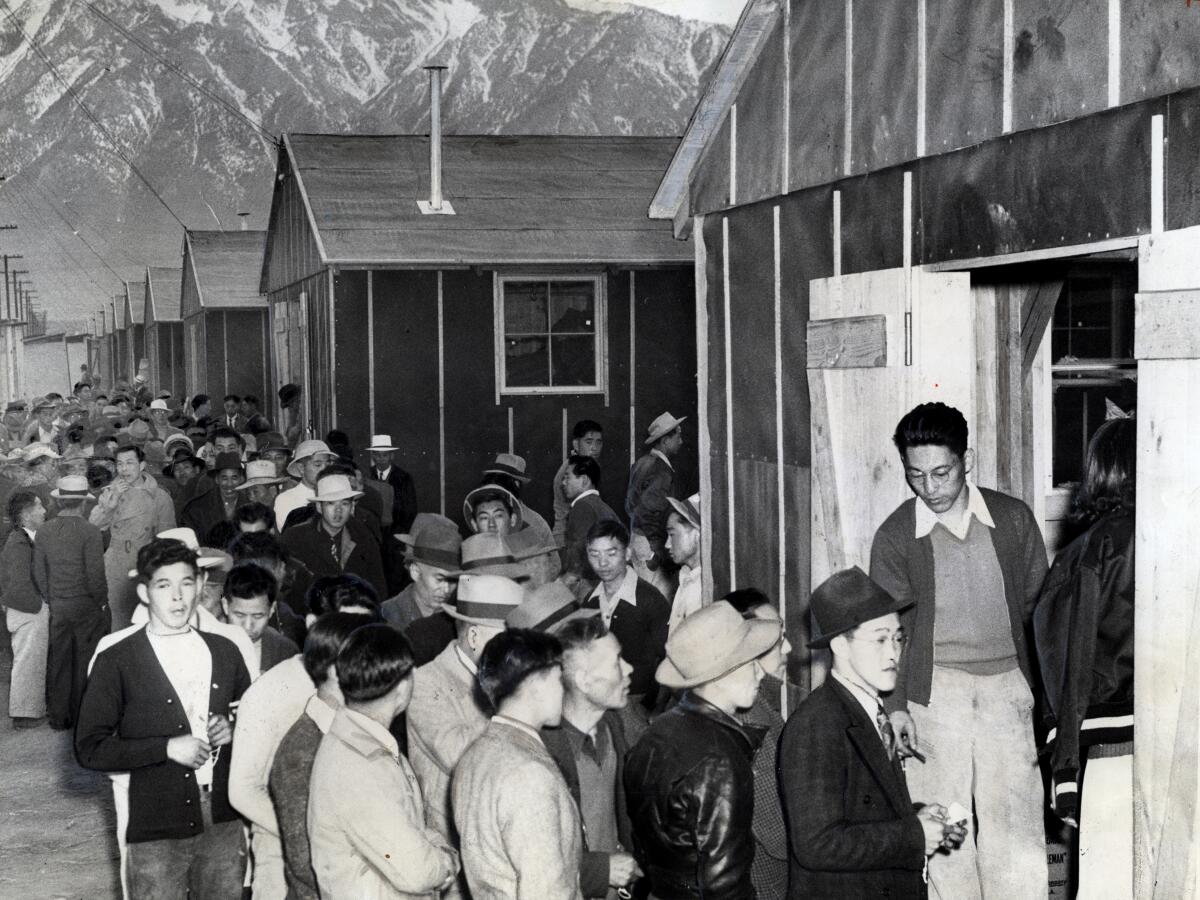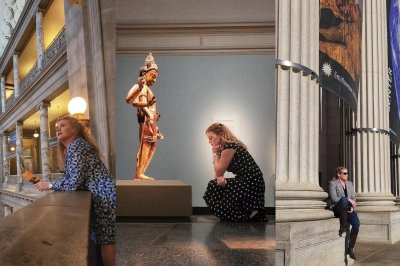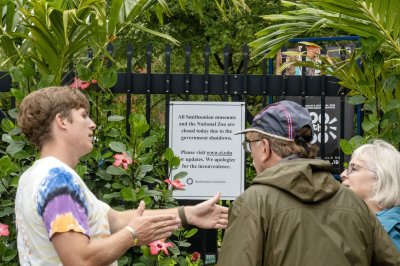Volunteers race to preserve U.S. history ahead of Trump edicts
A famous Civil War-era photo of an escaped slave who had been savagely whipped. Displays detailing how more than 120,000 U.S. citizens of Japanese ancestry were forcibly imprisoned during WWII. Signs describing the effects of climate change on the coast of Maine.
In recent months, a small army of historians, librarians, scientists and other volunteers has fanned out across America’s national parks and museums to photograph and painstakingly archive cultural and intellectual treasures they fear are under threat from President Trump’s war against “woke.”
These volunteers are creating a “citizen’s record” of what exists now in case the administration carries out Trump’s orders to scrub public signs and displays of language he and his allies deem too negative about America’s past.
More than 120,000 people of Japanese ancestry were forcibly relocated and incarcerated in camps during World War II, including these Japanese Americans seen at Manzanar in the Owens Valley in 1942.
(LA Library)
“My deepest, darkest fear,” said Georgetown University history professor Chandra Manning, who helped organize an effort dubbed Citizen Historians for the Smithsonian, is that the administration plans to “rewrite and falsify who counts as an American.”
In March, Trump issued an executive order entitled “Restoring Truth and Sanity to American History” arguing that, over the past decade, signs and displays at museums and parks across the country have been distorted by a “widespread effort to rewrite our Nation’s history,” replacing facts with liberal ideology.
“Under this historical revision,” he wrote, “our Nation’s unparalleled legacy of advancing liberty, individual rights, and human happiness is reconstructed as inherently racist, sexist, oppressive, or otherwise irredeemably flawed.”
He ordered the National Parks Service and The Smithsonian to scrub their displays of content that “inappropriately disparages Americans” living or dead, and replace it with language that celebrates the nation’s greatness.
The Collins Bible — a detailed family history recorded by Richard Collins, a formerly enslaved man — is seen at the National Museum of African American History and Culture in Washington, D.C.
(Kent Nishimura/Los Angeles Times)
That’s when Manning’s colleague at Georgetown University, James Millward, who specializes in Chinese history, told her, “this seems really eerie,” Manning recalled. It reminded him of the Chinese Communist Party’s dictates to “tell China’s story well,” which he said was code for censorship and falsification.
So the professors reached out to friends and discovered that there were like-minded folks across the country working like “monks” in the Middle Ages, who painstakingly copied ancient texts, to photograph and preserve what they regarded as national treasures.
“There’s a human tradition of doing exactly this,” Manning said. “It feels gratifying to be a part of that tradition, it makes me feel less isolated and less alone.”
Jenny McBurney, a government documents librarian at the University of Minnesota, said she found Trump’s language “quite dystopian.” That’s why she helped organize an effort called Save Our Signs, which aims to photograph and preserve all of the displays at national parks and monuments.
The sprawling network includes Manzanar National Historic Site, where Japanese American civilians were imprisoned during the Second World War; Fort Sumter National Monument, where Confederates fired the first shots of the Civil War; Ford’s Theater National Historic Site in Washington, D.C., where Abraham Lincoln was assassinated; and the Martin Luther King, Jr. National Historic Park.
It would be difficult to tell those stories without disparaging at least some dead Americans — such as the assassins John Wilkes Booth and James Earl Ray — or violating Trump’s order to focus on America’s “unmatched record of advancing liberty, prosperity and human flourishing.”
At Acadia National Park in Maine, where the rising sun first hits the U.S. coast for much of the year, signs describing the effect of climate change on rising seas, storm surge and intense rain have already been removed.
McBurney doesn’t want volunteers to try to anticipate the federal government’s next moves and focus only on displays they think might be changed, she wants to preserve everything, “good, bad, negative or whatever,” she said in a recent interview. “As a librarian, I like complete sets of things.”
And if there were a complete archive of every sign in the national park system in private hands — out of the reach of the current administration — there would always be a “before” picture to look back at and see what had changed.
“We don’t want this information to just disappear in the dark,” McBurney said.
Another group, the Data Rescue Project, is hard at work filling private servers with at-risk databases, including health data from the Centers for Disease Control, climate data from the Environmental Protection Agency and the contents of government websites, many of which have been subject to the same kind of ideological scrubbing threatened at parks and museums.
Both efforts were “a real inspiration,” Manning said, as she and Millward pondered what they could do to contribute to the cause.
Then, in August, apparently frustrated by the lack of swift compliance with its directives, the Trump administration sent a formal letter to Lonnie G. Bunch III, the first Black Secretary of the Smithsonian, setting a 120-day limit to “begin implementing content corrections.”
Days later, President Trump took to Truth Social, the media platform he owns, to state his case less formally.
“The Smithsonian is OUT OF CONTROL,” he wrote, “everything discussed is how horrible our Country is, how bad Slavery was, and how unaccomplished the downtrodden have been.”
Even though the Smithsonian celebrates American astronauts, military heroes and sports legends, Trump complained that the museums offered nothing about the “success” and “brightness” of America, concluding with, “We have the “HOTTEST” Country in the World, and we want people to talk about it.”
People visit the Smithsonian Museum of American History on the National Mall in Washington.
(Pablo Martinez Monsivais / Associated Press)
Immediately, Manning and Millward knew where they would focus.
They sent emails to people they knew, and reached out to neighborhood listservs, asking if anyone wanted to help document the displays at the 21 museums that make up the Smithsonian Institution — including the American History Museum and the Natural History Museum — the National Zoo and the United States Holocaust Memorial Museum.
Within about two weeks, they had 600 volunteers. Before long, the group had grown to over 1,600, Manning said, more people than they could assign galleries and exhibitions to.
“A lot of people feel upset and kind of paralyzed by these repeated assaults on our shared resources and our shared institutions,” Manning said, “and they’re really not sure what to do about it.”
With the help of all the volunteers, and a grad student, Jessica Dickenson Goodman, who had the computer skills to help archive their submissions, the Citizen Historians project now has an archive of over 50,000 photos and videos covering all of the sites. They finished the work Oct. 12, which was when the museums closed because of the government shutdown.
After several media outlets reported on the order to remove the photo of the whipped slave from the Fort Pulaski National Monument in Georgia — citing internal emails and people familiar with deliberations who spoke on the condition of anonymity because they were not authorized to comment publicly — administration officials described the reports as “misinformation” but declined to specify which part was incorrect.
A National Parks Service spokesperson did not respond to requests for comment for this story.
But the possibility that the administration is considering removing the Scourged Back photo is precisely what has prompted Manning, and so many others, to dedicate their time to preserving the historical record.
“I think we need the story that wrong sometimes exists and it is possible to do something about it,” Manning said.
The man in the photo escaped, joined the Union army, and became part of the fight to abolish slavery in the United States. If a powerful image like that disappears from public display, “we rob ourselves of the reminder that it’s possible to do something about the things that are wrong.”




